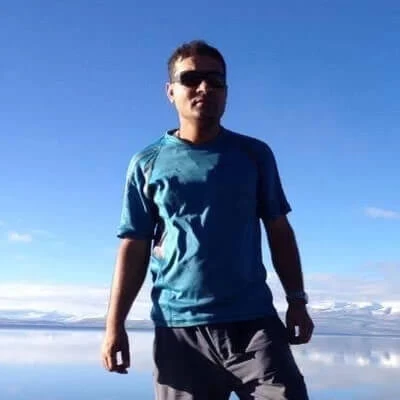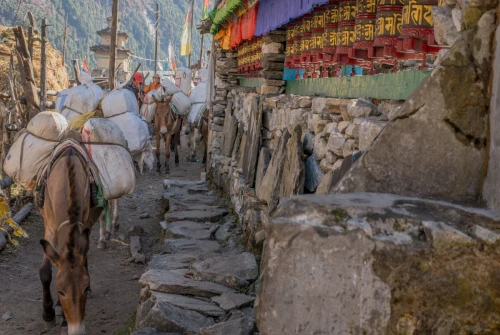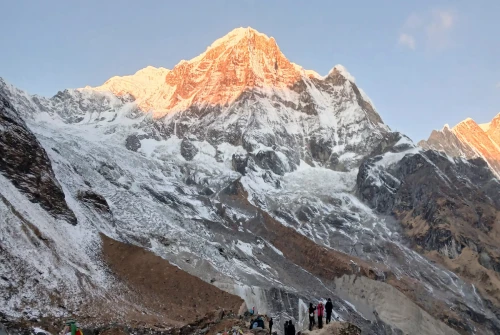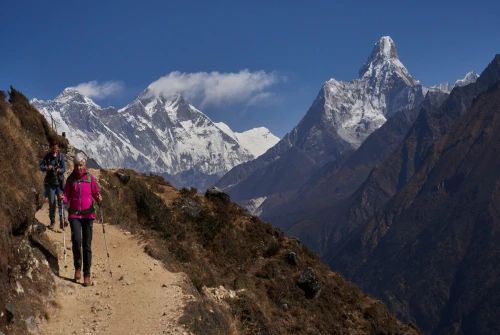Mera Peak
Elevation: 6,476 meters (21,247 feet)
Location: Hinku Valley, Everest Region, Nepal
Parent Range: Mahalangur Himalayas
First Ascent: Mera Central: May 20, 1953, by Col J.O.M Roberts and Sen Tenzing.
Route: Mera Glacier
Mera Peak, standing at 6,476 meters, is situated in the Mahalangur Himalayas within Nepal's Everest Region. It holds the distinction of being the highest trekking peak in Nepal. Mera Peak encompasses three primary summits: Mera Central (6,461m), Mera North (6,476m), and Mera South (6,065m).
Nestled in the Hinku Valley, Mera Peak is an ideal choice for beginners in the world of mountaineering. It is classified as a trekking peak by the Nepalese Mountaineering Association (NMA), indicating that it involves less technical climbing. This peak is particularly well-suited for newcomers seeking their initial climbing experience. The route takes you through the Hinku Valley in the Everest Region, involving trekking and glacier traversing.
The historic first ascent of Mera Peak was achieved in 1953 by the renowned Col. Jimmy Roberts and Sen Tenzing. Since the peak's exploration in the 1950s by mountaineering pioneers like Edmund Hillary, Eric Shipton, Tenzing Norgay, and George Low, it has been climbed by many. It has also served as a preparatory peak for climbers planning to tackle eight-thousanders, making it a valuable training ground.
Key Highlights of Mera Peak Climbing:
- It's the highest trekking peak in Nepal.
- Offers breathtaking 360-degree panoramas of prominent peaks like Mt. Lhotse, Cho Oyu, Makalu, Everest, and more.
- Provides a firsthand trekking experience in the Khumbu Region.
- Allows for an exploration of the rich and distinctive local culture and lifestyle.
- Offers a comprehensive mountaineering and trekking adventure.
Island Peak
Elevation: 6,160 meters (20,210 feet)
Location: Khumbu, Everest Region, Nepal
Parent Range: Khumbu Himal
First Ascent: Hans Rudolf Von Gunten in 1956.
Route: North Ridge
Island Peak, also known as Imja Tse, is a prominent mountain in the Everest Region of the Himalayas. Standing tall at an impressive elevation of 6,160 meters, Island Peak Climbing is highly sought after and ranks among the most popular trekking peaks. The peak's distinctive appearance, resembling an island amidst a vast expanse of snowy terrain, gives it the name "Island Peak," although its actual name is Imja Tse.
Island Peak is a magnet for novice climbers from all corners of the globe, providing an ideal platform for their first climbing experience. However, it is not only favored by beginners; it is also highly regarded among experienced climbers as an acclimatization peak. The climb is not excessively technical, making it accessible to a wide range of climbers. The journey to the summit rewards adventurers with breathtaking mountain vistas in all directions.
The southwest summit of Island Peak was first conquered by a renowned British expedition team in 1953. This ascent served as part of their training and acclimatization process. Among the heroic climbers in the group were Tenzing Norgay, Charles Wylie, and Charles Evans. Subsequently, the main summit was successfully reached by Hans-Rudolf Von Gunten in 1956.
Key Highlights of Island Peak Climbing:
- One of the most popular trekking peaks in Nepal.
- Positioned near the base of Lhotse, the fourth tallest mountain in the world.
- Offers a picturesque trekking experience in the Everest Region.
- Involves traversing diverse landscapes, including rivers, valleys, villages, and forests en route to Island Peak.
Which one is the easier climb between Mera and Island Peak?
While both Mera Peak and Island Peak are accessible to climbers without extensive mountaineering experience, Mera Peak is generally considered the less challenging option. It's important to note that these peaks, despite being classified as trekking peaks, should not be underestimated, and climbers must be prepared for hard work and unwavering determination.
In terms of elevation, Mera Peak has a slightly higher summit compared to Island Peak. However, the ascent to Island Peak involves steeper ice climbs, numerous demanding sections, and a formidable headwall. On the other hand, Mera Peak offers a more straightforward climb with fewer obstacles such as crevasses. The climb to Island Peak is made even more challenging by the presence of a narrow rocky ridge, a glacier traverse to the summit, and several icefalls, contributing to its higher level of difficulty. Therefore, when considering ease of ascent, Mera Peak tends to be viewed as the less demanding choice.
However, it's worth noting that when comparing the trekking sections leading to the respective base camps, the route to Mera Peak's Base Camp is more challenging until you reach that point. In contrast, reaching the Base Camp of Island Peak is notably easier and less strenuous. So, while Mera Peak is generally easier to climb overall, the trekking portion to its Base Camp presents its own set of challenges.
Mera Peak Difficulty Level
Mera Peak Trek is categorized as a trekking peak by the Nepalese Mountaineering Association, which implies that it is a suitable choice for newcomers to climbing with little to no technical challenges. Climbing Mera Peak is considered relatively straightforward, and individuals with basic climbing training and good physical endurance can successfully attempt it. Prior climbing experience is not a prerequisite for Mera Peak, making it less technical when compared to Island Peak. It involves ice trekking and climbing without the complexities of crevasses or narrow ridges. However, the climb does present its own set of challenges, including high altitudes, steep terrain, rough sections, glacier and snowy paths, long trekking days, and remote conditions.
Island Peak Difficulty Level
Island Peak's difficulty level is slightly higher than that of Mera Peak, primarily due to increased technicality. Nevertheless, both peaks fall into the trekking peak category, which is suitable for novice and inexperienced climbers. While Island Peak does require some basic climbing skills, it does not necessitate prior technical experience. Climbers should be comfortable using equipment like ladders, crampons, axes, ropes, etc. The technical aspects include navigating crevasses, narrow ridges, a headwall, and sections with icefalls. Challenges on Island Peak also include high-altitude trekking, extended trekking days, steep trails, rugged terrain, extreme weather conditions, and snowy sections. Success on Island Peak can be achieved with good basic climbing training and physical endurance.
Mera Peak vs. Island Peak : Trekking/Climbing Route
When comparing the trekking and climbing routes for Mera Peak and Island Peak, it's evident that both journeys offer distinct experiences. For Mera Peak, the adventure kicks off with a scenic flight to Lukla, followed by a trek through lush jungles and remote valleys leading to the Hinku Valley, where the ascent to Mera Peak begins. The climbing itinerary typically spans approximately 18 days, with essential overnight stops in Paiya, Kothe, Panggom, Thankak, and Khare before reaching Mera High Camp at 5,780 meters. The final ascent to the summit involves using fixed ropes and jumars. Trekkers must be prepared for weather delays, necessitating 2-3 spare days in the itinerary. In summary, the route for Mera Peak climbing spans from Kathmandu to Lukla, Chutanga, Zatra La, Thuli Kharka, Kothe, Thangnag, Khare, Mera Peak Base Camp, Mera High Camp, Mera Summit, Mera High Camp, Mera Base Camp, Khare, Kothe, Thuli Kharka, Lukla, and back to Kathmandu.
On the other hand, Island Peak's climbing route can typically be completed in around 15 days and combines trekking and mountaineering. It follows the standard Everest Base Camp Trek trail, incorporating a climb to High Camp and ultimately to the summit. The Island Peak route, while slightly shorter in duration than Mera Peak, is known for its challenging ascent, with technical sections. Although climbers can opt to extend their journey to include visits to Everest Base Camp and Kala Patthar, adding 4-5 more days, it is considered more demanding than Mera Peak. The ideal route for Island Peak Climbing starts in Kathmandu, proceeding to Lukla, Phakding, Namche Bazaar, Tengboche, Dingboche, Chukhung Ri, Chukhung, Island Peak Base Camp, Island Peak Summit, Chukhung, Namche Bazaar, Lukla, and finally back to Kathmandu.
In essence, while both peaks offer incredible trekking and climbing experiences, Mera Peak is often perceived as a relatively more straightforward climb in terms of technicality and can take a bit longer, whereas Island Peak's route is slightly more challenging but shorter in duration, with the option to incorporate iconic Everest region landmarks into the journey.
Best season For Climbing: Mera Peak vs. Island Peak
The best seasons for embarking on the ascent of Mera Peak are spring and autumn. During these periods, climbers can expect a relatively stable climate, which greatly enhances the chances of a successful summit. Regardless of the timing you choose for your climb, it's important to note that the temperature in the higher elevations remains cold, albeit manageable. Conditions at greater altitudes can become precarious, and climbers need to exercise caution. The overall weather can turn harsh, with frigid temperatures, so waiting for calm and favorable weather conditions for the summit push is crucial.
In contrast, Island Peak offers a wider window for climbing throughout the year, except during the core monsoon months from mid-June to the end of August when weather conditions are unfavorable. However, the most ideal times for Island Peak climbing are spring, spanning from March to early June, and autumn, from September to November. During these seasons, the weather tends to be stable, and temperatures are more bearable. The skies remain clear, providing unobstructed views. With lower chances of precipitation and snowfall, climbers generally feel more comfortable during these months. Some adventurous climbers have successfully attempted the ascent in winter, but the extreme cold can be challenging, especially for those new to mountain climbing. While Island Peak is not technically demanding to summit, it ultimately depends on one's comfort level with extremely cold temperatures during the winter months.
Required Permits: Mera Peak vs. Island Peak
For those planning to climb Mera Peak, several permits are necessary:
Makalu Barun National Park Entry Permit: This permit is required for entry into the Makalu Barun National Park and is priced at NPR 3,000 per person for foreign nationals and NPR 1,500 for SAARC nationals. It can be obtained at either the Nepal Tourism Board office in Bhirkhutimandap or Kothe. The fee may vary depending on your nationality.
Mera Peak Climbing Permit: The cost of this permit depends on the season in which you plan to climb and is categorized as follows:
- USD 250 per person for spring (March to May)
- USD 125 per person for autumn (September to November)
- USD 70 per person for off-seasons (December to February and June to August)
For those undertaking the challenge of Island Peak, the following permits are essential:
Khumbu Rural Municipality Entrance Permit: Priced at NPR 2,000 per person, this permit is required for entry into the Khumbu Rural Municipality. It can be obtained in Lukla or Monjo but is not available in Kathmandu.
Sagarmatha National Park Entry Permit: To enter the Sagarmatha National Park from Jorsalle, you must obtain a separate permit known as the Sagarmatha National Park Entry Permit, which costs NRs. 3,000 per person. This permit can be acquired at the park's entrance in Monjo.
Island Peak Climbing Permit: Similar to the Mera Peak Climbing Permit, the cost of the Island Peak Climbing Permit varies depending on the season:
- USD 250 per person for spring (March to May)
- USD 125 per person for autumn (September to November)
- USD 70 per person for winter (December to February)
- USD 70 per person for summer (June to August)
These permits are essential for ensuring compliance with park regulations and to support conservation efforts in the respective regions.
Accommodation and Food: Mera Peak vs. Island Peak
When embarking on a Mera Peak climbing expedition, you'll find teahouses available for accommodation up to the village of Khare. However, for the remaining 2 to 3 nights leading up to the summit push, you'll rely on camping tents. The teahouses along the trekking route typically offer basic amenities, providing clean rooms, shared bathrooms, hot water, warm blankets or quilts, and meals (both dinner and breakfast, usually served at the same teahouse where you stay overnight). As for food options, expect a range of Nepalese dishes with a few international varieties. Common choices include Daal Bhat (a combination of rice, lentils, vegetables, and pickles), momo dumplings, various soups, Tibetan bread, chapatti, chow mien, and spaghetti.
In the case of Island Peak, the trekking route offers more accommodation options, especially up to Dingboche valley. Teahouse accommodations are available up to Chukhung village, beyond which you'll transition to tented camps for one or two nights. Food choices along the Island Peak trail are quite similar to those on the Mera Peak route. Teahouses typically have their own menus, although food options may become more limited as you gain elevation. You can still enjoy staples like Daal Bhat, momo dumplings, a variety of soups, Tibetan bread, chapatti, chow mien, spaghetti, and more. Both climbing expeditions provide suitable accommodations and a diverse range of hearty meals to fuel your adventure in the Himalayas.
Additional Facts about Mera and Island Peak:
Island Peak is locally known as Imja Tse, a name change that occurred in 1951 when a group of mountaineers found its appearance oddly resembling an island.
Mera Peak boasts three distinct summits: Mera North (6,476 meters), Mera South (6,065 meters), and Mera Central (6,461 meters). Among these, Mera North is the tallest and most challenging, with only a select few mountaineers daring to attempt its ascent. Mera Central, on the other hand, is relatively more straightforward and stands as the most popular choice for climbers.
Both expeditions are led by experienced climbing guides and support crews. They offer the opportunity to relish 360-degree panoramic views of snow-capped mountains, including the majestic Mount Everest, while also presenting a daring itinerary for those starting the trek through Hinku Valley via Amphu Laptsa, an impressive additional view en route. The adventure begins with a scenic flight to and from Lukla, the gateway to the Everest region. Exploring the world-renowned culture and way of life of the Sherpas, experiencing beautiful landscapes with rare flora and fauna within Sagarmatha National Park and Makalu Barun National Park, and discovering hidden lakes like Seto Pokhari at elevations exceeding 5,000 meters are some of the unique aspects of these expeditions.
Both Mera and Island Peaks provide an incredible Himalayan summit experience, serving as an excellent introduction to high-altitude peak climbing. These climbs offer breathtaking Himalayan vistas in the Everest region, making for an exciting and thrilling adventure. However, it's crucial to recognize that climbing is an inherently daring and perilous sport, with yearly fatalities. Therefore, climbers bear the ultimate responsibility for their safety, a guiding principle of Nepal climbing and mountaineering. Those without an acceptance of this responsibility may find climbing to be an unsuitable pursuit. Given the technical nature of these mountains, climbers are encouraged to seek assistance from reliable climbing guides and support crews to ensure a safe and successful ascent.
Similarities between Mera Peak and Island Peak
Mera Peak and Island Peak share several notable similarities. Firstly, they are both located in the Barun sub-section of the Mahalangur section within the Nepalese Himalayas. Secondly, these peaks are of comparable elevation, with Island Peak standing at 6,189 meters (20,305 feet) and Mera Peak at 6,461 meters (21,190 feet). Additionally, these two peaks are in relatively close proximity to each other within the same region.
Furthermore, both Mera and Island Peaks fall into the category of trekking peaks, meaning that climbers do not require specialized technical climbing experience to attempt their ascents. Despite these commonalities, it's important to note that each of these peaks offers a distinct adventure and experience for travelers, with unique challenges and scenic rewards.
Additional Tips for Mera Peak and Island Peak Climbing:
- Prepare your body adequately for the expeditions by focusing on physical fitness.
- Include cardio, strength training, and mental conditioning in your fitness regimen.
- Engage in basic climbing training to familiarize yourself with climbing techniques.
- Educate yourself about altitude sickness and its symptoms.
- Ensure you have the necessary clothing and high-quality gear ready for the climbs.
- Secure comprehensive travel insurance that covers your climbing activities.
- Choose the peak that resonates most with your personal goals and preferences.
- Plan your expedition with a reputable and experienced agency for a smoother experience.
- Select the right timing for your climb based on the most suitable season.
- Request an expert climbing guide and a well-trained support team.
- Prioritize acclimatization to adapt to high altitudes effectively.
- Avoid rushing or pushing yourself beyond your limits; take it at your own pace.
- Follow the guidance and instructions provided by your climbing guide.
- Mentally prepare yourself to cope with a variety of circumstances and challenges that may arise during the climbs.
Conclusion
In conclusion, both Mera Peak and Island Peak offer remarkable and unique experiences, but they vary significantly in terms of the level of difficulty they entail. Mera Peak is the preferred choice for those seeking more accessible routes, making it suitable for climbers with less experience. On the other hand, Island Peak presents a greater challenge and should only be pursued by climbers who possess a strong understanding of mountaineering techniques and ample experience. Ultimately, the choice between these two peaks comes down to individual preferences and the availability of resources and time for the expedition.




